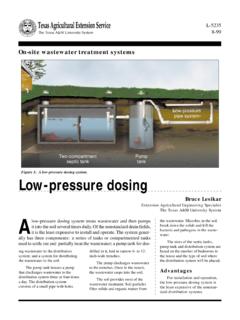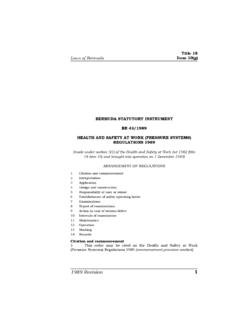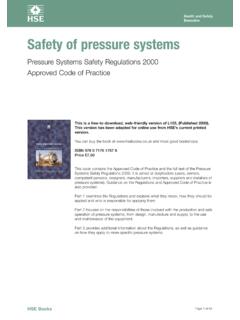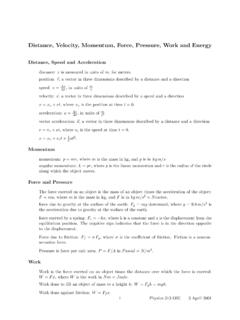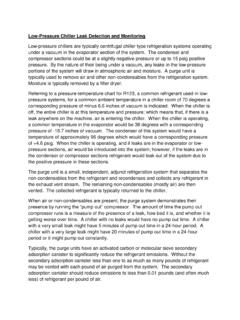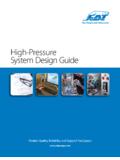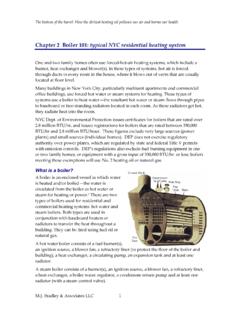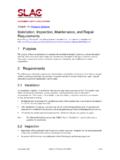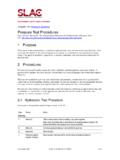Transcription of Pressure Systems Safety - Exor
1 Pressure Systems Safety Guidance Note 38. Jan 14. 1. Pressure system Safety Modern Pressure Systems have a good Safety record; however they present particular hazards because Pressure vessels can release large amounts of stored thermal and kinetic energy following leaks or explosion of gases, fluids, vapours or steam. Due to the complexity of the legislation, with its varying exceptions, it is strongly recommended that if you have a Pressure system of any type to seek advice from a competent person. Your insurance company should be able to put you in touch with an appropriate engineer. You must identify a responsible person to run the Pressure system on a day-to-day basis. Responsibilities and Duties There is a split of responsibilities and duties, which is dependent on whether the system is a fixed installation or mobile. Differentiation is also made between owner and user. Owner The duties for the owner are assessed on whether they have control over the operation of the system or if they are leasing or hiring out the equipment.
2 This applies if the system is: An installed system fixed in a permanent location. If the system is controlled by its owner, they are regarded as the owner and the user so they are therefore responsible for ensuring full compliance with the Regulations. In tenanted or leased premises, for example, public houses or multi-occupied buildings, the system owner and its users may be different A mobile system capable of being transported to other sites or premises. If the system is used by the owner or leased or hired out, the owner is responsible for ensuring full compliance with the Regulations. User Once it is installed, the user has primary responsibility for the Pressure system , in particular: Training and safe operation Maintenance Action in case of emergency Safe operating limits Written scheme of examination Periodic examination of system Keeping records. SA GN 38 (V1) 2. Jan 2014. The user has also to ensure that before the system is used by him or his employees the following is completed: Suitable and sufficient risk assessments are performed The system is and remains suitable for the purpose intended Protective personal equipment is provided if required.
3 Where the owner or his agent do not have a place of business in Great Britain, the user assumes all the responsibility for compliance with the Regulations. Pressure system A Pressure system is defined as: Any system comprising of one or more Pressure vessels of rigid construction, their associated pipework and protective devices The pipework with its protective devices to which a transportable Pressure receptacle is, or is intended to be, connected A pipeline and its protective devices, which contain or are liable to contain a relevant fluid, but does not cover transportable Pressure receptacles. Equipment Types A Pressure system covers anything that contains a relevant fluid'. Typical examples of this type of equipment are: Boilers and steam heating Systems Pressurised process plant and piping Compressed air Systems (fixed and portable). Pressure cookers, autoclaves and retorts Heat exchangers and refrigeration plant Valves, steam traps and filters Pipework, hoses, Pressure gauges and level indicators Vapour compression refrigeration Systems that exceeds 25kW.
4 Relevant Fluid This is steam at any Pressure , or any fluid or mixture of fluids that may exert a Pressure in excess of bar (7 lbf/in2). Fluids include gases, liquids or vapours - for example compressed air, nitrogen, oxygen, acetylene, pressurised hot water, etc. SA GN 38 (V1) 3. Jan 2014. General Safety Requirements for Pressure Systems Principle Causes of Incidents The principal causes of incidents include: Poor equipment and/or system design Poor maintenance of Pressure equipment Unsafe Systems of work leading release of Pressure Operator error through poor training/supervision Poor installation Inadequate repairs or modifications. Hazards of Pressure Systems Typical hazards associated with failure of Pressure Systems are: Impact from the blast of an explosion or release of compressed gas or liquid Impact from parts of equipment that fail Contact with the released liquid, gas or steam, including compressed air Fire resulting from the escape of flammable liquids or gases Compressed air Systems may fail at the point of connection of flexible hoses linked to portable tools, causing the unsupported length of hose to whip or snake violently.
5 Reducing the Risk of Pressure system Failure The degree of risk from Pressure - system failure depends on these factors: Skills and knowledge of the people that maintain, test and operate the equipment Pressure of the system Type of liquid or gas and its properties Suitability of the equipment and pipework that contains it Age and condition of the equipment Complexity and control of operation Prevailing operating conditions ( high-temperature processes). Daily Checks All checks should be in accordance with the manufacturer's recommendations. These may include: Pressure settings and gauge readings Fluid levels Valve operations, including signs of regular discharges Control- system operation Condition of protective devices General cleanliness (housekeeping) in and around the system . SA GN 38 (V1) 4. Jan 2014. These regular checks should form part of a safe system of work . Provide safe and suitable equipment Ensure that equipment is suitable for the intended purpose Ensure that the materials of manufacture are suitable for the liquids or gases they will contain Ensure that the system can be operated safely without having to climb or struggle through gaps in pipework Be careful when repairing or modifying a system .
6 What are the Operating Conditions? Is the gas or liquid toxic or flammable? What are the process pressures and temperatures? What are the safe operating limits? Is there a set of operating instructions for all of the equipment? Have the operators had suitable training on the operating instructions? Fit Suitable Protective Devices Protective devices include Pressure relief valves and electronic gear which close the system down in case of malfunction. You should ensure: Protective devices cause shutdown when temperature, Pressure or levels are exceeded Protective devices are adjusted to correct settings Audible and visual warning devices are noticeable Protective devices are kept in good working order at all times Safety valves and bursting disc discharge towards a safe place Once set, protective devices can only be altered by an authorised person. The flowchart overleaf will help you decide if the Regulations apply to your Pressure system SA GN 38 (V1) 5. Jan 2014.
7 Reference: Appendix 1 - Safety of Pressure Systems : ' Pressure Systems Safety regulations 2000. SA GN 38 (V1) 6. Jan 2014. Written Scheme of Examination for Pressure Systems All Pressure Systems that contain steam or any other relevant fluid above a 250 bar litre capacity must not be used unless they are subject to an individual written scheme of examination. The scheme enables a periodic and systematic inspection of the main Safety hazards of the specific equipment - it is a maintenance handbook for the system concerned. The written scheme will identify which parts are to be examined, what is required and how often it is required. It will deal with the first examination before being put into service, and subsequent examinations throughout the system 's working life. The user/owner is responsible for ensuring the suitability of the scope of the written scheme and that it covers all the Pressure vessels, protective devices and pipework. Frequency of Examination Examination periods will vary depending on the type of system , its age and its use.
8 Periods can vary between 12 and 144 months. Examination in Accordance With the Written Scheme The owner/user must ensure that the equipment is periodically examined by a competent person in accordance with the written scheme. They must also ensure the Safety of the examiner by performing the required preparatory work . Examination Report Details The report obtained from an examination should include: Name and address of the owner Address and location of the system and name of the user if different Whether subject to a written scheme Identification of system or parts examined Condition of system or parts examined Parts not examined Result of examination Any repairs needed and the timescale for completion Any changes in the safe operating limits and the date by which they should be made Any change in the written scheme of examination Date by which the next examination must be completed Other observations Where the most recent examination was postponed names, date of relaxation and new date examination was to be completed Date examination took place SA GN 38 (V1) 7.
9 Jan 2014. Name and address of competent person Signature Date of report. Keep Documentary Records The owner/user should keep the following documents readily available: The most recent examination report under the written scheme Designer/manufacturer/supplier's documents relating to parts of the system included in the written scheme Any documents required to be kept by the Pressure Equipment Regulations 1999. Any agreement or notification relating to postponement of the most recent examination under the written scheme All other reports which contain information relevant to the assessment of system Safety Records of abnormal or particularly arduous operating conditions should be kept if they will be of use or relevance to the competent person during the next examination. Where a system is sold or changes hands the previous owner has a duty to pass over all documents held under this regulation to the new owner/user. Competent Person The scheme must be drawn up by a competent person with the necessary knowledge and experience and independence to undertake the functions required of them.
10 They should be able to demonstrate that they have practical and theoretical knowledge and actual experience of the relevant Systems . They may be: An in-house inspection department An individual (self-employed). An organisation providing an independent inspection service. Bodies holding United Kingdom Accreditation Service (UKAS) accreditation to BS EN. 17020:2004 for the scope of in-service inspection of Pressure equipment, can provide competent persons meeting the appropriate criteria. For more details of accredited companies UKAS can be contacted as follows: United Kingdom Accreditation Service (UKAS). 21-47 High Street Feltham Middlesex TW13 4UN. Tel: 0208 917 8400. Website: SA GN 38 (V1) 8. Jan 2014. Overview Do you have Pressure Systems which contain a relevant fluid where the Pressure x volume of the largest Pressure vessel is less than 250 bar litres? If yes', Have you established safe operating limits and do you maintain the system properly? Do you have Pressure Systems which contain a 'relevant fluid' where the Pressure x volume of the largest Pressure vessel is greater than 250 bar litres or a system containing steam?

